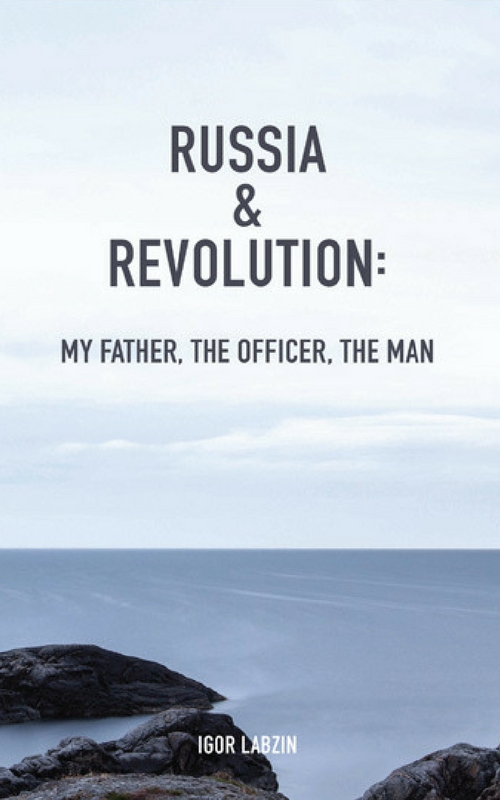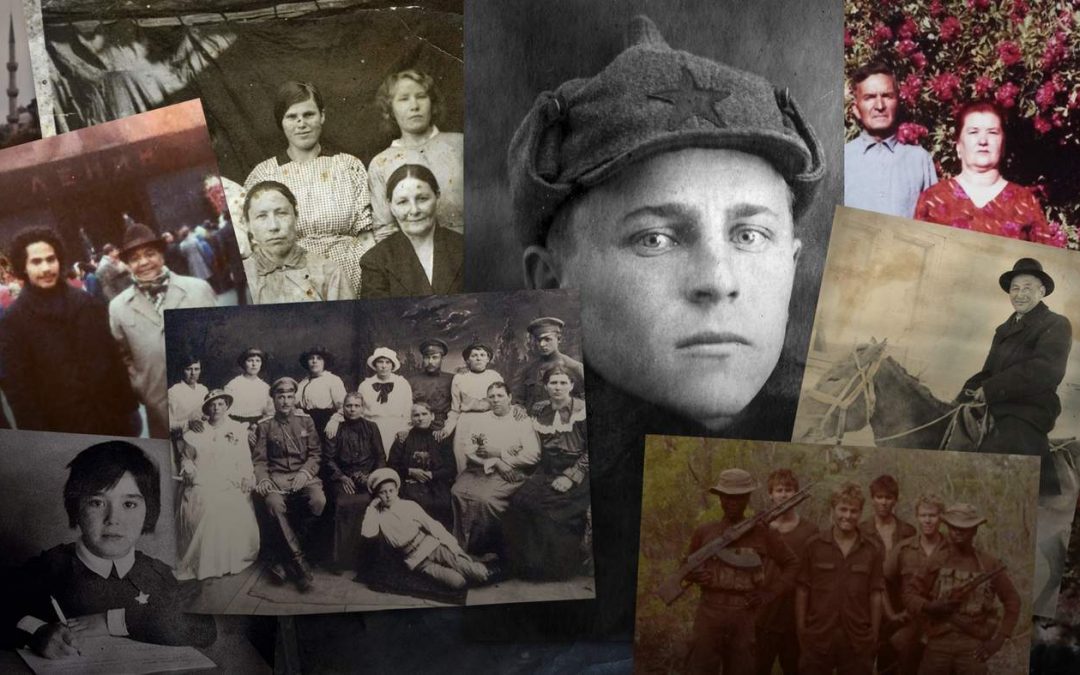
by admin | Mar 18, 2018 | Blog
White Russian émigrés in the US, in Europe in the UK! Sure, there are plenty of them. But what about in Australia, New Zealand, Venezuela, Brazil? Who are the Russian émigrés and what is their Russian ancestry?
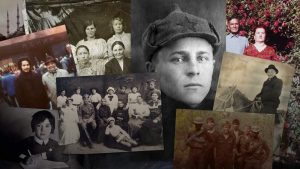
(Image: http://www.bbc.co.uk/news/resources/idt-sh/russian_revolution_and_me)
You may be surprised to know that almost in all corners of the world there are pieces of Russian émigrés’ history that seem to have been blown all over the world like confetti at a wedding. Many of their tales are lost forever but some survive.
Making Meaning: Russia’s Lost Émigrés
For example, in Australia there are Old Believers (Starovertsy) who came to Queensland in the early 1930’s and settled in a country town called Yarwun/Targinnie in Central Queensland and scratched out a living growing and selling paw paws (papaya). How do I know? Well when I was working as an engineer in Gladstone in Central Queensland in the 1970’s constructing wharves, we had a few guys working as carpenters and they spoke Russian and told me stories about the locals in Yarwun from where they came.
In itself, the history of the Old Believers is quite something. Just like in the Catholic Church who had a schism when Martin Luther proclaimed his demands for reform which subsequently led to the creation of the various Protestant churches, so also with the Russian Orthodox Church. However in the case of the latter, it was the reforms promulgated by Patriarch Nikon in the mid 1600’s that were resisted by parts of the church as being too radical (crossing yourself with three fingers instead of two etc.etc.) that led the Old Believers to split from the Orthodox Church.

(Image: Australian Census Demographic Map – dark green areas indicative of Russian communities)
On the other hand, there is the case of Vladimir Vasilivich Bodisco (1912 -1998) a Russian émigré who went to Venezuela via a long stint in Serbia, learned Spanish and applied his veterinary science training to breeding cows that could withstand the heat and humidity of the country to yield lots of milk. Even received a medal from the government for his efforts. If you would like to know more about Vladimir Vasilivich Bodisco’s story, you can read about it in my book (p. 152).
So if your grandparents or parents were Russian émigrés and there are old medals, swords, uniforms or photographs gathering dust, wipe off the dust and do some research. You may find a new window through which to look at their world.
The wonderful world of communications today is at your behest. Start with the usual online searches, and then search in Google in Cyrillic and a completely new world opens up!
From there you can contact the various government archives in Russia, email museums and libraries. One thing leads to another and soon you are going to bed late because you have been glued to the monitor reading captivating information that you had no idea existed before this.
By the way, the Russians seem to have a high regard for keeping accurate records in their archives and have a great fascination in what happened to their countrymen that were scattered to the four winds.
Some of the sites that I have encountered are:
Russians in Yarwun/ Targinnie
https://www.gladstoneobserver.com.au/news/apn-searching-for-the-forgotten/103024/
http://deniswright.blogspot.com.au/2011/05/white-russians-of-yarwun.html
Russians in Queensland
http://qldruscentre.com/russians.php
Russian cattle breeding in Venezuela
http://www.oac.cdlib.org/findaid/ark:/13030/kt9m3nc1r5/entire_text/
If you would like to know more about my useful resources used for tracking Russian ancestry go to RUSSIAN ANCESTRY SEARCH RESOURCES

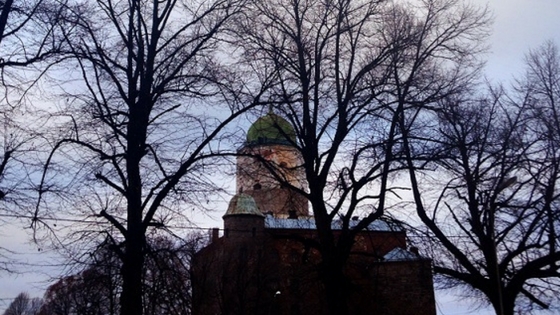
by admin | Apr 25, 2016 | Blog
On a cold, blustery late autumn day, I am on the shore of a body of water, probably part of the harbour or river, in Vyborg. A place that I had never imagined that I would ever visit until, whilst in St Petersburg, I received an invitation to come to Vyborg to do a book presentation about Sergei Mintslov.
Together with Michail Efimov, Julia Moshnik and my wife Jay, we walk toward the medieval castle that seems to be far away, when our attention is drawn in a direction that neither of us had thought of looking towards. Then we see the reason for the excitement of our hosts. It is the Clock tower that features on the cover of my translation of Faraway Days, by Sergei Mintslov, my grand uncle’s book.
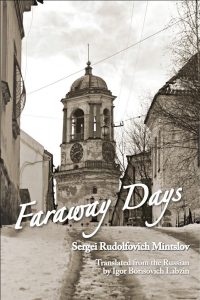
English Translation of Faraway Days by Igor Labzin
We both stop in our tracks, staring unbelievingly at the structure, which hitherto had been nothing more than a photograph on the front of my book. Vyborg was until then just a name on a map.
So why Vyborg, a city in Russia, not far from the Russian Finnish border?
This is where my grand uncle, Sergei Mintslov, who wrote Faraway Days back during the early days of the Russian Revolution, comes into the picture. You see, he wrote it in on his estate in Kamere, which these days, is an outlying suburb of Vyborg.
The couple, Michail and Julia, that have met us at the railway station and who are now escorting us, via a walk around the old part of Vyborg to the 13th century Castle that is now a museum, are a husband and wife team of local historians who have a keen interest in Sergei Mintslov.
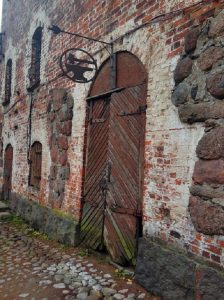
Inside the walls of Vyborg’s Medieval Castle
Vyborg Castle Museum
After a quick orientation tour of the city centre with them, we arrive at the Castle and warm up over a cup of tea with biscuits, before taking a close up look around the back corridors, rooms and staircases of the castle. It is the first ever experience for both of us to be able to see at such close quarters the inside of a castle, rather than the usual few rooms that are made available for viewing by tourists.
This castle has not yet been totally refurbished and “polished up” so as to become part of the global tourist track. Its floors and walls still show the wear and tear of the many years of service as a fortress manned by soldiers. We are then left to our own devices for a few hours before the commencement of the presentation of my book, Faraway Days, in the main hall of the castle that evening. Probably the very same room where in days of old, the Swedish and Teutonic knights would while away the night prior to setting off for a battle in the morning.
Vyborg certainly has a lot of history behind it. Founded by the Swedes in 1293 by Torkel Knutsson, whose statue still stands in the main square, it changed hands numerous times between the Swedes and the Russians and between Russia and Finland in the period of the Russian Revolution and the end of World War II.
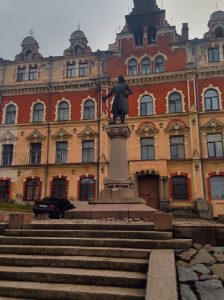
Statue of Knutsson in Vyborg
Mon Repos
We wander off to Mon Repos park, a good half hour walk from the city centre. It is considered to be one of the jewels in the crown of the city. The land was bought by Ludwig Heinrich von Nicolai in 1788 and remained in the family until 1943, when Soviet Russia retook Vyborg.
Mon Repos, on a cold autumn day is somewhat daunting but fascinating with its autumn colours, piles of chopped wood, old tumble-down timber buildings and lichen and moss covered tree trunks. It is the very epitome of not only Russia but also of northern Europe. Its large rock outcrops are a rarity in this part of the world and are much admired by the locals who flock to the park in summer.
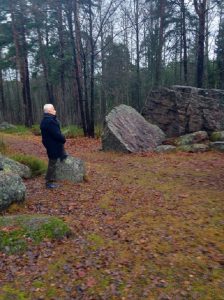
Mon Repos rock garden
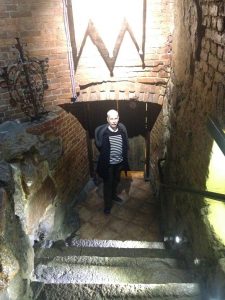
Slavjanskaja Trapeza Restaurant, Vyborg
Having had as much cold fresh air as our bodies could stand, we seek shelter in a bistro recommended by Michail and Julia, the couple that met us at the railway station. It is fantastic!
The Slavjanskaja Trapeza restaurant is located in a basement carved out of stone in the old part of town. Crouching slightly so as not to hit our heads on the low stone ceilings, and having been at first mistaken for Finnish tourists, but then feted for coming all the way from Australia, we settle into a real Russian culinary journey of fish soup, grilled salmon and of course, to keep a grip on reality, a plate of potato chips.
All this quaffed down with a bit of the local beer, and tea, but not too much, as we have to keep our wits about us for the evening presentation. It’s top notch.
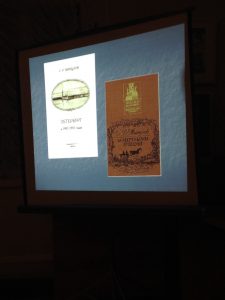
Books by Sergei Mintslov
My presentation on Sergei Mintslov starts with great promise and proceeds to get better and better as the event proceeds. The director of the museum, Vladimir Tsoy, just like all his colleagues, has no air of stuffiness about him. Au contraire, they are young, smart and energetic! An absolute delight to be in their turbo-charged atmosphere, juxtaposed with the 13th Century Castle in which they work.
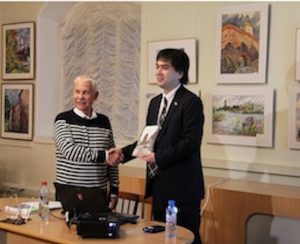
The Director of the Castle Museum
The locals have also turned out in force for the presentation, the local Vyborg Times, the Local TV station and all the Mintslov aficionados of the district, including a local scholar, Michail Kostolomov, who is a recognised scholar of all things Mintslov, including Mintslov’s eccentric, as some would have it, sister Anna.
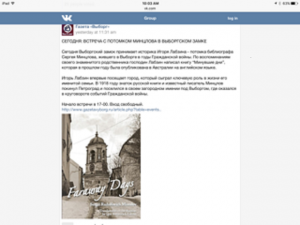
Article in the Vyborg Gazette November 2015
Following the end of the presentation and interviews with the local media, we walk the quiet streets along the river, under the streetlights, to the railway station with Michail and Julia. On the train, which travels at speeds of up to 150 km per hour, we arrive in St Petersburg an hour or so later.
Back in our hotel room just off Nevsky Prospect, we are both dazed, not only with the rapidity of the day’s events but also with the discovery of an unknown part of the world and its attendant history that was hitherto unknown to us.
A day never to forget and always to cherish!
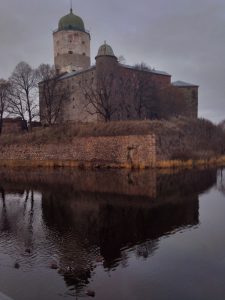
Vyborg Castle

by admin | Mar 19, 2016 | Blog
Tips On What To Do With Old Russian Memorabilia
Babushka has moved into a nursing home and you don’t know what to do with all of her beautiful old Russian memorabilia, books and mementos. They are family treasures and you don’t want to throw them out but then again it takes up room to store it and anyway you cannot read Russian so what’s next. It starts to feel like a fine line between fascination and ordeal.
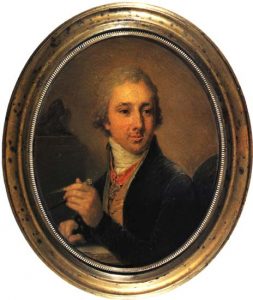
Who is interested? The Dom is. That’s The Dom Russkovo Zarubezhya (Foundation of Russians Abroad) in Moscow – interested in tokens from the 20th century especially of Russian émigrés who left Russia to make new lives in other countries.
Rummage through the boxes and here is what you may find.
Old letters and documents in Russian dating back to 1917
This piece of memorabilia lists the names of the young officers who were graduating from the St Petersburg Naval Academy, who swore their oath of allegiance to Tsar Nicholas II prior to the outbreak of the revolution.
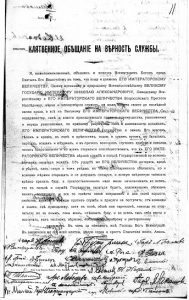
Oath of Allegiance
Dusty stained photo albums with precious photos falling out of the stick on “corners” on the black pages. If you are lucky, there in faded pencil on the back, are the names of those in the photo. Sometimes there is the year and sometimes a precious comment to reveal a snippet of a story around the pic. This one is of the White Officers on manoeuvres in Eastern Russia in 1922.
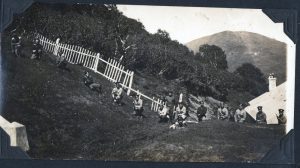
On manoeuvres on the Kamchatka Peninsula, Far East Russia, circa 1922
Valued Russian Books
Books ranging from St Petersburg Naval Academy text books to the classics of Tolstoy, Pushkin and Chekhov to cookbooks with the foreword written by Stalin. The covers may be tatty and discoloured, the pages dog-eared but they evoke the culture of the era of the silver age of Russian literature.
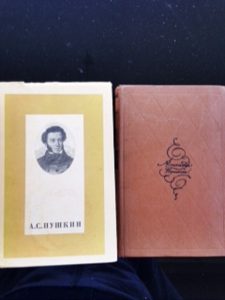
Pure Vintage Clothes
Yes the op shops would love the old suits and dresses, maybe a slightly squashed hat or two but definitely the gloves, the bowties and cigarette cases evoke memories of the glamorous 30s and 40s. There may be pieces of old military uniforms or the cap and epaulettes of the ship captain or his pipes and ashtrays all memorabilia jumbled together in the leather hat box with the stickers of voyage destinations many years ago.
Sea Trunks full of Collectibles
Open them up and dig around through some old blankets and newspapers wrapped around things. What are they? The sexton in another box of its own; stained leather binoculars; old worn tobacco tins.
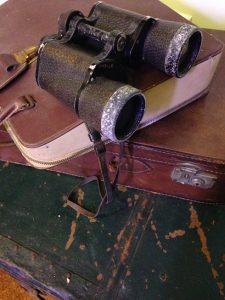
What’s next?
What does the Dom do with these pieces of Russian memorabilia and why are they interested?
Their work is concentrated on the preservation of Russian culture and history of Russian émigrés through research and documentation, presentations and displays of aspects of life prior to and after the Russian Revolution and tracking the stories of White Russians who fled from Russia in the 20th century. What happened to these people? What are their stories? That is why your babushka’s keepsakes may be of great interest to them.
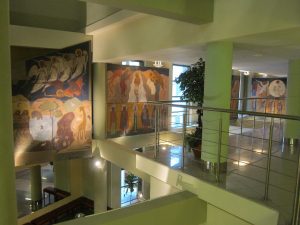
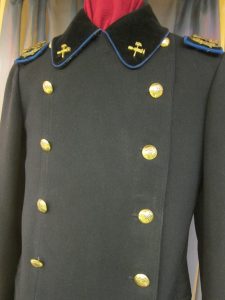
You can visit the library and gallery at the Dom, view special displays and their art gallery.
Contacting the Dom is easy – go to http://www.domrz.ru
Contact them at info@bfrz.ru – tell them what you have, are they interested?
Interested in the real story around these photos and the Russian Memorabilia – it’s all in my book Russia and Revolution: My Father, The Officer, The Man























